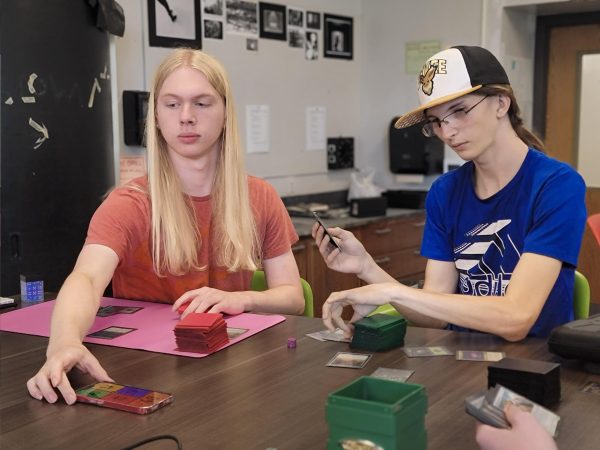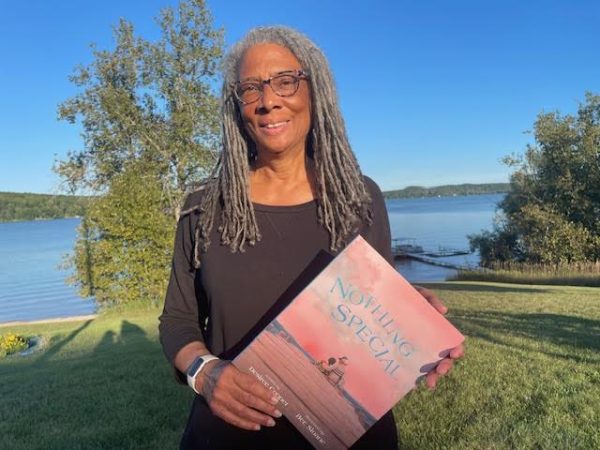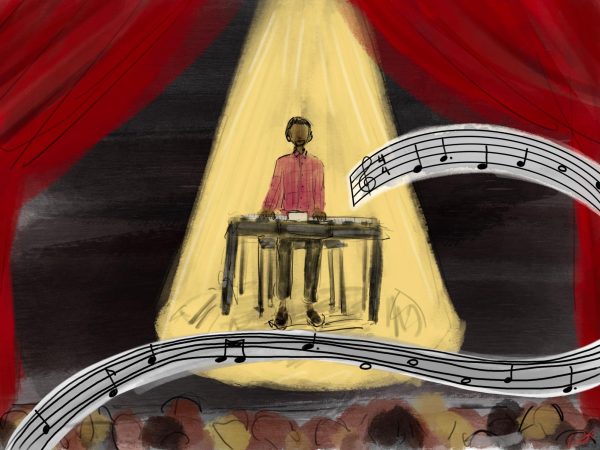Closing The Umbrella: The Lasting Influence of Arnold Palmer
Now black and white umbrella resembles Arnold Palmer’s signature green, white, and red umbrella.
“I think Arnold Palmer will be remembered as a person that never lost his sense of identity of where he came from. Probably because of that, Arnold will be one of the most loved and respected athletes in American history,” Dr. Doug Clark, a close personal friend of Palmer, said about the influential golf superstar.
On Sunday, Sept. 25, Arnold Palmer passed away shortly before undergoing heart surgery at the University of Pittsburgh Medical Center.
Palmer, also known as “The King”, was one of the most loved and respected athletes in American history. He had a profound influence on 20th century America as one of the greatest golfers of all time, and as one of the most captivating celebrities of the mid 1900s.
On Sept. 10, 1929, Palmer was born to Milfred J. “Deacon” Palmer and Doris Palmer in Latrobe, PA. At age four, Palmer swung his first golf club, that was crafted for him by his father. At age 11, he began caddying at the country club, and by the age of 17, Palmer had won his first amateur golf championship.
From 1955 to 2011, Palmer won a total of 92 professional victories. He claimed 62 U.S. tour victories, 18 international victories, and 11 senior tournament victories. He collected seven major titles in his career, including four Masters championships. In this time, he hit 21 hole-in-ones for 3305 yards of perfect shooting. The Associated Press named him Athlete of the Decade for the 1960s.
His father, Deacon Palmer, played a large role in his characterization. Deacon Palmer was a golf pro and groundskeeper at Latrobe Country Club, which he helped found. “Originally Arnold could not go into the clubhouse when the members were there,” Clark said. ”He only played at night after the members left. They weren’t the wealthy family at all, so his dad always emphasized that Arnold had to be very respectful to all of the members. Arnold took that throughout his life to be respectful to everybody.”
One particular moment that Clark remembers was when he went to watch the 1991 Masters tournament. “He and Jack Nicklaus and Gary Player tee’d of on number two, and everyone was saying hello to all of them,” Clark said. “So I yelled at Arnie and he waved to me and then he walked about five yards further. Then, he turned around and he walked right to the gallery where I was standing. But whether it was me, or whether is was somebody who worked in the locker room, or the lady who worked at the grocery store, the mailman, he just treated everybody with respect… The neat thing was that he always seemed like he had time for you. And it’s not just me, it’s people he might not know nearly as well.”
One of the things that made him such a personable figure was his ability to connect with people. “You could be Zuckerberg or you could work at an auto factory in Michigan, and you’d relate to him,” Clark said, “Very few people relate to that spectrum of people in human society.”
Arnie’s Army was the name given to his fanbase. They began as a group of soldiers who gathered at the 1959 Masters to cheer on defending champion Arnold Palmer. “I can’t remember another time, other than my stint in the Coast Guard, when so many uniformed soldiers surrounded me,” Palmer said about his army, “A year later, when I won my second Masters title, I thanked the ‘army’ of supporters who came out to follow me.” From there, Arnie’s Army grew into a much larger movement. Today, the Arnie’s Army Charitable Foundation helps fund organizations that work to support youth development, pediatric health, and the environment on a local level.
“If you ask anybody on the street ‘who are the three most charismatic, memorable people, or characters?’ they’d probably say Muhammad Ali, Arnold Palmer, and Babe Ruth, in terms of connecting with the people,” Clark said. However, these may not be the things that define him as such a revolutionary figure. He was at his peak when television began broadcasting golf tournaments. This gave him a platform that no athlete had ever had before. “The other thing I think he will be remembered for is that he probably was the first person who became a brand, Arnold Palmer,” Clark said, “You can go around the country and ask for an Arnold Palmer and everyone knows that’s iced tea and lemonade. His little umbrella is a symbol everybody knows.”
This list of truly iconic athletes is limited. “He probably did not make more than $100,000 in any one prize, but I think his net worth when he died exceeded 500 million, and that’s because he became a brand,” Clark said, “Arnold Palmer was probably the first original brand.”
Fortunately, Palmer used his platform for good. Over the years, Palmer raised millions of dollars in charitable funds. He held six golf galas at Latrobe country Club, where he would invite three other friends such as Greg Norman or Tiger woods to play golf with him. The money from those galas went to Latrobe Hospital and the University of Pittsburgh Medical Center for prostate cancer research.
His biggest charity project was the Arnold Palmer Medical Center. Palmer and his late wife Winnie Palmer founded the Arnold Palmer Hospital for Children and Women along with a group of local Orlando pediatricians. Later, the medical center split into the Arnold Palmer Hospital for Children and the Winnie Palmer Hospital for Women and Babies. The medical center has been actively trying to advance specialized pediatric care for over 27 years.
One thing that not a lot of people knew Palmer for was his love for aviation. “The other thing I think people will locally remember him for is he just loved to fly. He was an aviator,” Clark said, “He flew long before it was ‘in vogue’, so to speak. That’s certainly one of the things I will remember him for.” In 1961 he purchased an Aero Commander 500 following his first solo flight. He used this for much of his traveling on tour. He continued to build his airplane collection throughout his life. In total, Palmer logged over 18,000 hours of flying time.
No matter where he went, he always knew his true home was in Latrobe. He was born there, and put to rest there. “Even though he never stopped being that world ambassador and one of the best known sports figures in the twentieth century and into the twenty-first century, I think the thing that was most unique about him was that when he was home, he was home. He was somebody from Latrobe, and he wanted to identify with that, and it made him comfortable… That was something very unusual for someone who could go anyplace in the world.”
From aviation to iced tea, Arnold Palmer had an immeasurable impact on the world. He will be remembered by his ability to both be an icon, and touch so many lives. “He could relate to everybody because he knew who he was,” Clark said, “He had a sense of self worth, and he didn’t try to be ostentatious or somebody who he wasn’t.”








